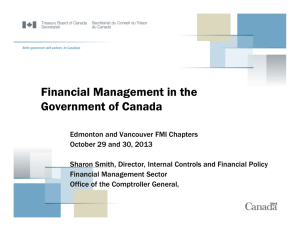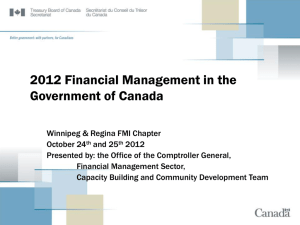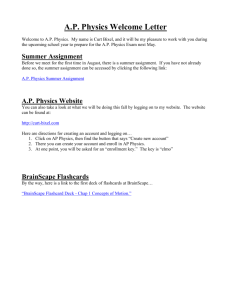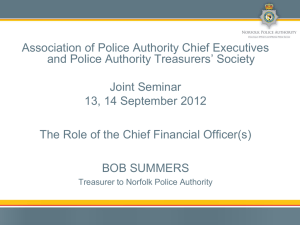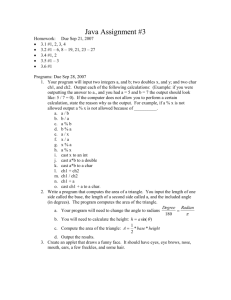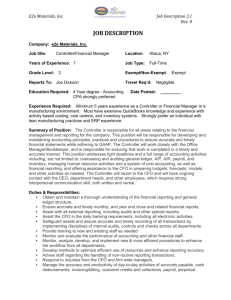Discount Rates For Public Sector Employee Benefit And
advertisement
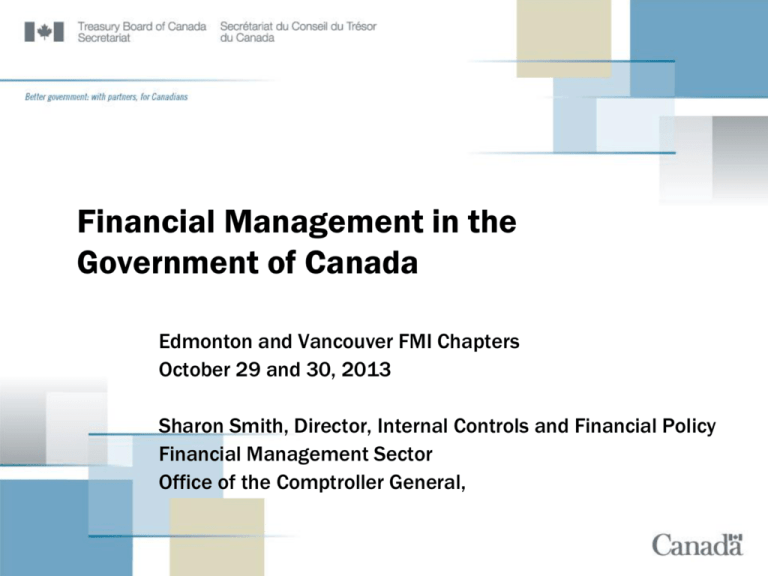
Financial Management in the Government of Canada Edmonton and Vancouver FMI Chapters October 29 and 30, 2013 Sharon Smith, Director, Internal Controls and Financial Policy Financial Management Sector Office of the Comptroller General, Agenda • Current environment • Financial Policy initiatives • Financial Management Community initiatives • Career management 2 Current Environment 3 The Financial Management Environment 237.1 B revenues 369,000 FTEs >1 M payments per working day 5 DFMS* in use 88.2% expenditures managed through SAP* 132 Departments & Agencies 90% FTEs in departments using SAP* 239.6 B expenses Sources of Data: * With HRSDC as an SAP user 2010-2011 Public Accounts 2012-2013 Departmental RPPs Association of Canadian Financial Officers Administrative Systems Inventory 2011-2012 4 Return to Balanced Budgets • Canada expects a full recovery from the 2006 Financial Crisis by 2014/2015 Source: http://www.budget.gc.ca/2012/plan/chap1-eng.html#a10 5 Canada’s Fiscal Outlook • Projected total government net debt, 2016 Source: http://www.budget.gc.ca/2012/plan/chap6-eng.html 6 Current Environmental Context • Economic recovery and balanced budget; • Cost containment and SFT Operating Budget freeze; • Back Office efficiencies and service consolidation; • Meeting expectations of Parliamentarians; and • Supporting ministerial and enterprise-level decision-making. 7 Financial Management Transformation Key Messages for Today • Inclusive and sound governance for Financial Management Transformation (FMT) is in place • FMT Program will leverage existing work and best practices • Approach: Financial management systems first, then financial management services • New CIOB IT direction = Application Management Services (AMS) will be outsourced • FMT now includes Grants & Contributions 8 FMT - Transformation Approach • Timely, agile and responsive data. • Streamlined, and automated processes. • Consolidated systems platforms. • Leverage foundation to accelerate standardization and consolidation. • Rigorous investment plan and performance measurement. • Harvest and re-use solutions (e.g. ESDC), and support initiatives building core capability. • Assess alignment: continue, re-vector and halt on-going initiatives as appropriate. Initiate transparent performance measurement. • Continue to tighten policy requirements for process and information. • Increasing momentum towards standardization (FM-BP, CEDI, FM-SC); progress is hampered by decentralized current-state model. • Redundant investments in process and system changes continue; operational support costs remain high. 9 FMT- Increased Value-for-Money • Streamline and automate routine transactions; integrate information and processes across functional boundaries • Redirect resources to higher value services • Increase overall value provided to the business Current-State Value-added, business partner services Decision Support Target-Model Potential Savings Control Decision Support Reporting Control Transaction Processing Routine, process oriented services Departmental Financial Management Systems Reporting Transaction Processing GC Enterprise SAP 10 FMT - Next Steps • Fall 2013 – Complete the FMT business case (for funding) • Fall 2013/Winter 2014 – Accumulate high level business requirements, not detailed business processes like we previously did. • February 2014 (Est.) – Present to Board of Management and COGA • Summer/Fall 2014 – Work with departments to confirm potential convergence date, develop ‘readiness’ workplan. • April 2014 (Est.) – Build CC SAP configuration for less complex organizations 11 Financial Management Policy 12 FM Policy Context • 5 year review of FM policy suite – – – – – Effective stewardship of the public purse Reliable financial reporting Underpins FAA and regulations Roles and responsibilities Current risk environment • Alignment with transformative initiatives 13 Financial Management Policy Suite Responded to Federal Accountability Action Plan to review full FM suite Support deputy head responsibilities and expectations as accounting officers Maintaining Canada’s position among leading jurisdictions • The Treasury Board Financial Management Policy Framework articulated around four key policies: Policy on Financial Management Governance (effective April 2009) Policy on Internal control (effective April 2009) Policy on Stewardship of Financial Management Systems (effective January 2010) Policy on Financial Resource Management, Information and Reporting (effective June 2010) ± 25 Directives ± Standards (e.g. TBAS) 14 Policy on Internal Control • Reaffirms the responsibility of Deputy Heads, as accounting officers, for ensuring the maintenance of effective risk-based systems of internal control • With a focus on internal controls over financial reporting requires that Deputy Heads: – ensure the completion of an annual risk-based assessment of the departmental system of internal control over financial reporting (ICFR) – ensure the establishment of an action plan to address any necessary adjustments – include a summary of the assessment results and action plan to be attached as an Annex to a revised Statement of Management Responsibility accompanying the annual financial statements and signed by the DH and the Chief Financial Officer (CFO) – engage the Departmental Audit Committee or equivalent as appropriate on assessment plans and associated results 15 Levels of departmental internal controls DH as accounting officer Broad system of internal control System of IC ADMs CFO System of ICFM System of internal control in their area of responsibility System of internal control over financial management System of ICFR Policy requirements focus on ICFR 16 Annual risk-based assessment approach Financial Statements Start with annual financial statements - Identify key accounts - key risks and materiality Set scope and develop assessment plan Testing 3 levels of controls Design effectiveness: – key controls documented – in place as designed – aligned with risks Entity level (tone from the top) General IT level Operational effectivenesss: – key controls functioning over time Business process level 17 Directive on Travel, Hospitality, Conference and Event Expenditures • New focus on « events » October 3, 2012 • Travel – – – – Previous Budget caps Deficit reduction Political expectations New travel approval requirements August 1, 2013 • Challenges – – – – – Maximizing travel flexibilities Data capture and system complexities Linking costs (travel, hospitality and conference) to « event » approvals Administrative burden Training exclusions 18 Pay Modernization • Pay Consolidation – – – – Consolidation of PWGSC pay services in Mirimachi 3 waves of phased implementation (57 departments currently on board) Key issues in section 34 pay verification – functions moved to pay centre Departments must delegate authority for specific pay verification functions • Pay in Arears (PIA) – – – – New COTS Pay System for fall 2015 New staff hired on or after March 27 2014 on PIA Existing staff to have « transition payment » Financial authority for this payment 19 Other Policy Initiatives • Interdepartmental Settlements • Interdepartmental Charging • Tax Regime Changes • Payment on Due Date • Transfer Payment Policy – Performance report on Gs & Cs reforms under development – Final report expected to be released Winter 2014 20 CFO Attestation • CFOs will now provide evidence of their due diligence on Cabinet submissions through a formal CFO attestation letter • CFO’s attestation letter to be attached to TB Submission and summarized in MCs Due Diligence section – The attestation letter include the following six assertions with evaluation criteria and observations: • Assumptions with financial implications are documented/reasonable; • Significant risks with financial implications are identified and considered; • Financial resource requirements are disclosed; • Funding is identified and sufficient to address financial requirements; • Proposal is compliant with financial legislation and policies; and • Key financial controls and reporting are in place. • CFO provides explicit conclusion on the sufficiency of the financial information for decision-making • New guidelines embody the CFO model 21 Costing Centre of Expertise • New Costing Centre of Expertise (CCE) within OCG to supportDeputy Head and CFO accountabilities • Development of key costing guidance continues – Costing for major capital asset acquisition – Baseline cost of programs – Revisiting the Guide to Costing • TBS challenge function – Support departments in producing high-quality costs estimates – TBS capacity to challenge cost estimates – PCO to do challenge function on MCs 22 Financial officer community 23 Accounting Profession – CA-CMA-CGA Unification • The unification initiative is progressing quickly at the national and provincial levels. • A three-way unification completed in Quebec. • Proposals between CAs and Certified Management Accountants (CMAs) reached in many provinces except: – Alberta, where CMAs are poised to unify with the Certified General Accountants (CGAs); and – Ontario, where only the ICAO is supporting joining CPA Canada. 24 Canadian CPA Certification Program • Program Design • CPA Competencies • Program Details • Education • Examinations • Practical experience • Transition 25 CPA Impact on Recruiting and Development in the Government of Canada • OCG is actively following the merger discussions. • OCG will be reviewing the implications of the CPA merger and professional program on the financial officer community and the current recruitment and development programs. • Financial Officer Recruiting and Development Program 26 Financial Officer Training 27 Financial Officer Training– FI to CFO Career Path • Developed by the DCFO Council to help Financial officers and financial executives map out their career objectives and goals against predetermined criteria – Focus is on reaching a CFO position but can also be used for other specialized career paths within finance – Works on two dimensions: the number of levels before obtaining a CFO position and the specific requirements of each of these levels. • OCG has worked with the FM community to revitalize the FI to CFO Career Path (two distinct paths that interconnect). Will take into consideration requirements of CFO Talent Management Initiative. • New career path includes a “Welcome to the FM Community” page for each FI level in the career path and is housed on FM community GCPedia page 28 Financial Officer Training – FI Competencies • Benefits to using competencies: Employer’s Perspective Employee’s Perspective • Greater insight into breadth and depth of individual’s experience • Career management and progression. • Can substantiate information provided by individual through validation • More pointed and pertinent discussions regarding employee’s professional development requirements • Better understanding and verbalization of accomplishments and experience • Can substantiate work experience with concrete work examples • More pertinent feedback from manager/mentor on areas of professional development • Helps determine the “right fit” 29 Financial Officer Training – FI Competencies • FI Competency profiles – Behavioural (includes the 7 key leadership competencies) – – – – – – – Oral and written communications Risk Management Negotiation Values and Ethics Strategic Thinking: Analysis and Ideas Engagement Management Excellence: Action, People, Finance – Functional (based on four FM functional areas) – – – – accounting and reporting planning and resource management Financial policy, Financial Systems 30 Financial Officer Training – FI Competencies • The FI Competency Profiles and the Employee guide on Competencybased Management have been approved by the Comptroller General • An Employee and Manager’s guide on Competency-based Management have been developed. • All competency documents will be posted on the FM community GCpedia site • Training has been provided and is available in webinar format on the FMI website. 31 32 Financial Officer Training – FI Core Curriculum • 2013-2014 new activities: – Costing in Government courses: • Introduction to Costing in Government to be piloted on October 31, 2013; and • The Application of Costing in Government to be piloted on November 28-29, 2013 (Both courses will be available during winter of 2014) – Business Analysis course – to be piloted on November 18-20, 2013 (Course available in September 2014) – The Application of Revenue and Revenue Spending course: to be piloted on January 30-31, 2014 (course available in September 2014) – Integrated Risk Management course to be piloted on January 27, 2014 (course available in September 2014) 33 CFO Talent Management • Pilot courses with academia underway – Senior financial officers – Financial executives • Institute of Governance’s initial financial executive boot camp conducted (September 2013) • “Next Gen” CFO course to be piloted in November 2014 – Partnering with Deloitte & Touche • OCG to ‘evaluate’ pilot progress to determine next steps (Winter 2014) 34 Career Management 35 Staffing Process Poster & SoMC (Publiservice) Application (application form, covering letter, resumé, other documents) Part 1 Part 2 Screening Preparation (should start at time of application) Written Exam Interview Part 3 Closing the Process (Post-Mortem & Recourse) Black = employer Blue = prospective candidate 36 Poster • Actual job opportunity advertisement • Includes some of the information detailed on the Statement of Merit Criteria • Provides other information such as: • • • • • Area of selection – who and where* Closing date* General inquiries information (contact person) Where and how to submit your application Other information/requirements about the process: – – – – Documents required and format* Tools that may be used to assess candidates Results expected (job offers, pool of candidates, etc.) Any other important information for the candidates • It is important to submit all documents in the format requested and within the timeline indicated as failure to do so would affect your eligibility into the process * Part of selection criteria 37 Statement of Merit Criteria (SoMC) • Provides specific information about the requirements of the position (for screening and assessing purposes). What is on SoMC will be evaluated. • General Information – Selection process number, position title, classification(s), federal Must be clearly organization(s), location(s) demonstrated • Essential qualifications (must be met independently): – Elements used for screening purposes: • Screening Qualifications (education, experience, competencies) – Assessed by means of exams, simulations, interviews, etc. • For knowledge & competencies 38 Statement of Merit Criteria (SoMC) (cont’d) • Official Language Proficiency (must be met prior to hiring) • Conditions of Employment (Example: Security clearance) • Asset Qualifications (Qualifications that are not essential to perform the work, but which would, now or in the future, benefit the organization or be an enhancement in terms of the work to be performed). Can be used for screening & selection purposes • Operational Requirements (overtime, travel, etc.) • Organizational Needs (Used to target groups such as visible minorities, women, persons with disabilities, etc.). Can be used in selecting a candidate. 39 Screening • Documents/Information used for screening purposes: – – – – – Application Covering letter Resumé Supporting documents Deadlines • Education – Level of post-secondary education and institution • Experience – Use proper wording that reflects the requirements stated in the Statement of Merit Criteria (For example: coordinate ≠ manage) 40 Screening (continued) • Only candidates who meet the essential criteria can be screened-in for consideration • Supporting documents – Attach all other requested documents (Proof of education, citizenship documents, performance assessments from previous employer (s), etc.) – If you do not provide them, you may be screened-out • Deadlines – Screening factor – must be met • References 41 Application form & cover letter • Cover Letter (often used as a screening tool): – This is the first impression you make on the employer and shows how well you communicate in writing – Shows the employer why they should consider your résumé – Opportunity to highlight how your skills and qualifications will benefit the employer – If indicated in the poster, make sure you follow the desired format • For example, if required, use headings or bullet format Tip • Trap: Some candidates fail to use the required format in the cover letter and are screened-out on this basis 42 Resumé - Showcase yourself! – Highlight: • Your education - level of post-secondary education (diploma, degree, master’s, etc.) and institution • Your work history • Your work experience – remember to use proper wording (For example: coordinate ≠ manage) • Your acquired competencies & skills – Be clear, concise and demonstrate that you meet all essential qualifications identified on the SoMC 43 Resumé (cont’d) • Resumé should be: – – – – Written with the employer’s interests in mind Professional in appearance Targeted for a particular job or organization “Letter-perfect” - spelling and grammar mistakes = bad impression on potential employer – Honest and clear demonstration of your skills, abilities and achievements – Clear indication of what you offer to the employer 44 Tips and Tricks for a good Resumé • Useful link to help you prepare your resumé: – http://www.youth.gc.ca/eng/topics/jobs/resume.shtml • You can find a resumé builder on the following Service Canada website: – http://seekers.jobbank.gc.ca/commun-common/connection-login.aspx • Google can provide you with many “examples of resumés”. For example: – http://jobsearch.about.com/od/sampleresumes/a/sampleresume2.htm 45 Preparing for and participating in Exams and/or Interviews 46 Preparing for exams and/or interview • Remember, an interview is a two-way exchange of information – The interviewer is interested in three things: • Can you do the job? • Will you do the job? • Will you fit the job? • You will need to be able to demonstrate this during the interview and/or exam • You want to know if the organization is right for you and your career goals • Review SoMC and make sure you understand all elements which will be assessed in the exam or during an interview (knowledge, competencies & skills) 47 Preparing for exams and/or interview (continued) • “ABOUT YOU” QUESTIONS • SITUATIONAL QUESTIONS • KNOWLEDGE QUESTIONS • BEHAVIOUR BASED QUESTIONS • ROLE PLAY • Contact appropriate resources 48 Participating in the interview/exam • Arrival: – Arrive early – Bring requested documents (if any) – Dress for success – professional attire expected – appropriate footwear 49 Participating in the written exam • Exam: – Come well prepared • You've arrived a few minutes early, checked your appearance, are unfailingly polite and pleasant with reception • Come well-prepared (well-rested, pen & paper, watch, snack, water, documentation if allowed, etc.) – – – – – – Read all questions first and allot your time accordingly Answer questions you know first If time permits, check your work Neat and legible responses will assist the evaluator Solid communication skills are key Demonstrate you understand the bigger picture 50 Participating in the interview • At the interview: – – – – Make a solid first impression Demonstrate you understand the bigger picture Effective communications skills are key Present a detailed, specific and positive picture of what you can do, using concrete examples • Listening, confidence, and quality of presentation are the keys to successful interviewing. • Employers are looking for enthusiasm, some knowledge of the organization, confidence, and an ability to work well in their environment. • The interview is also your opportunity to assess the organization. Do you want to work there? Can you contribute, get new skills, have a chance to advance, or will this position open doors for you? – ask questions that show your knowledge of the organization – ask when they anticipate a decision will be made and how candidates will be informed 51 Performance Expectation and Feedback – valuable tools for you • Establishing performance expectations and obtaining feedback are important to supporting career development. • Take the initiative • Set goals with your manager • Request regular meetings to assess your progress • Use the performance appraisal mechanism to identify the training and development you need – the bars are rising • Create a learning plan and make the best possible use of it. 52 Opening Doors • Be on the look-out for new opportunities. • Remember to develop your soft skills: teamwork, leadership, communication and networking: – Take on stretch assignments; – Volunteer on a departmental committee or an interdepartmental working group; and – Get involved in volunteer activities such as FMI. • The better connected you are, the more doors will open. 53 Contact us: Sylvie Séguin, CGA Senior Policy Analyst sylvie.seguin@tbs-sct.gc.ca (613) 946-6242 Sharon Smith, Director Sharon.Smith@tbs-sct.gc.ca (613) 952-3350 Monique Main, CPA, CA Manager, FORD/IARD and CAST Monique.main@tbs-sct.gc.ca (613) 946-7635 54
